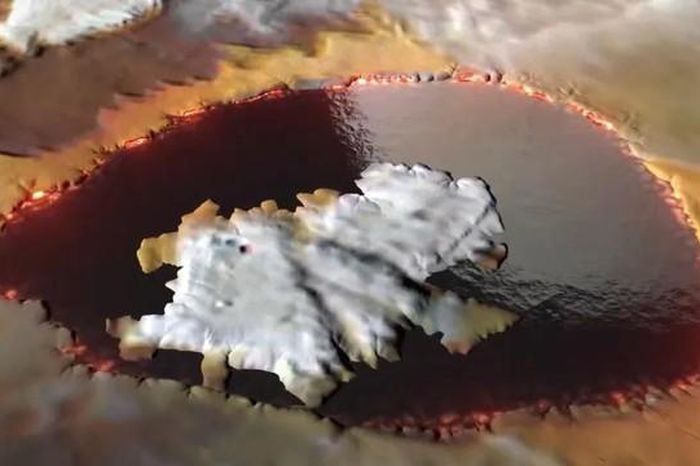NASA spacecraft nabs stunning view of comet Atlas streaking past the sun
The captivating space snowball Comet Atlas (C/2019 Y4) has provided astronomers with a ton of great photo ops in the six months since it was first discovered. The cosmic wanderer is in an all-out death dive toward the sun and, having been heated by our home star, is slowly breaking apart. But it's still alive! And the latest batch of images from a NASA spacecraft show the comet's journey past the sun in exquisite detail.

On Wednesday, Karl Battams, an astrophysicist at the Naval Research Laboratory, posted a magnificent short video of Atlas on its way through the solar system. Battams lead the Sungrazer Project, which uses images from solar telescopes maintained by NASA and the European Space Agency to look for moving objects around our star.
Battam's processed animation uses a series of images from NASA's Stereo-A spacecraft, a space-based observatory studying the sun, from May 30. Against a backdrop of stars, Atlas moves through the image on its journey through the solar system.
With some new image processing, here's a short animation of comet ATLAS in the @USNRL HI-1 field of view on @NASASun STEREO-A. (Full movie in next tweet.)
— Karl Battams (@SungrazerComets) June 2, 2020
Of note: Check out Mercury as it enters the upper-left corner of this field of view... Yes, Mercury has a tail! ☀️☄️ pic.twitter.com/MDo5jFHa1v
Atlas isn't the only interesting phenomenon appearing in the animation. Because the footage is captured by Stereo-A's heliospheric imagers, which are able to detect the solar wind, ghostly wisps of the stellar outflows are visible.
Another bonus? The planet Mercury, which sneaks into view from the upper-left quadrant as the animation continues. As Battams notes in his tweet, Mercury "has a tail," a trail of gas caused by the solar winds that pass over the planet. Mercury recently reached perihelion -- the point in its orbit closest to the sun -- when it was around 29 million miles from the star.
Atlas' closest approach to the sun was scheduled for May 31. Battams noted in a subsequent tweet he hopes to update the animation with further data in the coming days. Some astronomers have suggested Atlas could even disintegrate into "a haze of dust and gas" on closest approach.
The European Space Agency's Solar Orbiter, which launched in February to study the sun, passed through the comet's ion tail between May 31 and June 1 and is expected to pass through its dust tail on June 6 -- giving astronomers a rare chance to study the space rock in greater detail.
You should read it
- Hubble Space Telescope has just captured the 'crumbling moment of Comet Atlas'
- Trump's US Space Force successfully launches its first national security mission
- What's the Russian super officer's cell phone security that is twice as high as the iPhone X?
- Atlas: Ajax in Microsoft style
- We may be able to see the 'second moon' in the sky with the naked eye next May
- 25 most beautiful Milky Way photos in 2020
- Three potential landing locations are listed in the Martian Mission in 2020
- Impressive series that Cassini captured before 'suicide'
May be interested
- NASA's spacecraft soared to the asteroid that could destroy the Earth for specimens
 nasa's osiris-rex spacecraft is powered by earth to fly into space, beginning its journey to the asteroid bennu taking a few specimens and returning to earth in 2023.
nasa's osiris-rex spacecraft is powered by earth to fly into space, beginning its journey to the asteroid bennu taking a few specimens and returning to earth in 2023. - Return to the historic moment when NASA spacecraft landed on the Moon through a re-created film from over 14,000 photos
 a vivid, 1-0-2 film, meticulously and meticulously recreating the photographer's moment of breathtaking nasa spacecraft, the film maker christian stangl surprised many.
a vivid, 1-0-2 film, meticulously and meticulously recreating the photographer's moment of breathtaking nasa spacecraft, the film maker christian stangl surprised many. - NASA rover shares stunning images of Mars' moon Deimos
 nasa's perseverance rover - which has been on a mission to explore the surface of mars since 2021 - has just shared a stunning image of deimos, one of the red planet's two moons, back to earth.
nasa's perseverance rover - which has been on a mission to explore the surface of mars since 2021 - has just shared a stunning image of deimos, one of the red planet's two moons, back to earth. - How can extreme temperatures affect spacecraft? NASA is about to have the answer
 the parker solar probe is currently on its way to a destination just 3.8 million miles (about 6.1 million kilometers) from the sun's surface, literally immersed in the star's outer atmosphere—also known as the corona.
the parker solar probe is currently on its way to a destination just 3.8 million miles (about 6.1 million kilometers) from the sun's surface, literally immersed in the star's outer atmosphere—also known as the corona. - Clip NASA: 'Glass lake' in the most terrible place in the solar system
 nasa has just revealed incredible images from the juno spacecraft's close flight to 'hellfire' io.
nasa has just revealed incredible images from the juno spacecraft's close flight to 'hellfire' io. - Did NASA ships indirectly bombard other planets?
 the suicide dive of the nasa spacecraft named dart caused such a strong impact that our neighboring planet also 'suffered the blow'.
the suicide dive of the nasa spacecraft named dart caused such a strong impact that our neighboring planet also 'suffered the blow'. - Explore the universe through 5 NASA websites
 as a pioneer in space exploration, nasa has a unique view of the world. we often learn from them more or less.
as a pioneer in space exploration, nasa has a unique view of the world. we often learn from them more or less. - Leaving the solar system, the NASA ship sent back a confusing message
 one of nasa's spacecraft operating outside the heliosphere began sending meaningless messages to earth late last year, then went silent.
one of nasa's spacecraft operating outside the heliosphere began sending meaningless messages to earth late last year, then went silent. - Successfully launched the ultra-modern solar exploration spacecraft worth $ 672 million
 solar orbiter is one of the most modern spacecraft man has ever built
solar orbiter is one of the most modern spacecraft man has ever built - The NASA ship captured the moment the Korean ship flew in the opposite direction at a relative speed of about 11,500 km/h
 nasa released a series of images capturing the moment the korean spacecraft danuri flew across the moon's surface at high speed.
nasa released a series of images capturing the moment the korean spacecraft danuri flew across the moon's surface at high speed.










 Astronomers watch a dead star 'power up' for the first time
Astronomers watch a dead star 'power up' for the first time How to watch the 'strawberry' full moon and its subtle eclipse from anywhere on June 5
How to watch the 'strawberry' full moon and its subtle eclipse from anywhere on June 5 Three sets of skeletons reveal the tragic history of the first African people to reach America
Three sets of skeletons reveal the tragic history of the first African people to reach America Tesla's Cybertruck can be converted into armored tanks
Tesla's Cybertruck can be converted into armored tanks What is a bidet? Why do Japanese people prefer to use intelligent washing hose rather than toilet paper?
What is a bidet? Why do Japanese people prefer to use intelligent washing hose rather than toilet paper? Admire the unique photograph of the Moon and Earth taken from Mars
Admire the unique photograph of the Moon and Earth taken from Mars